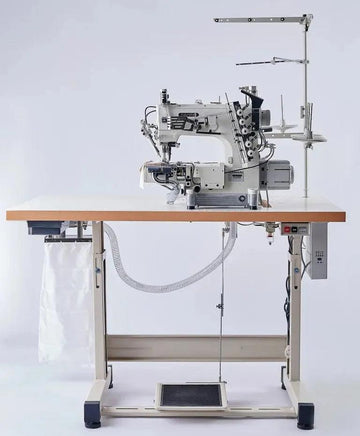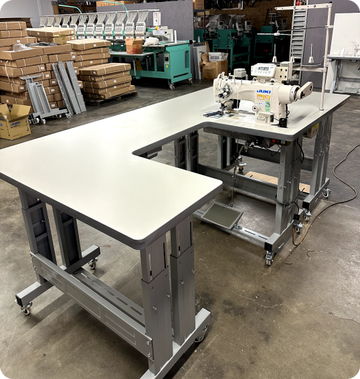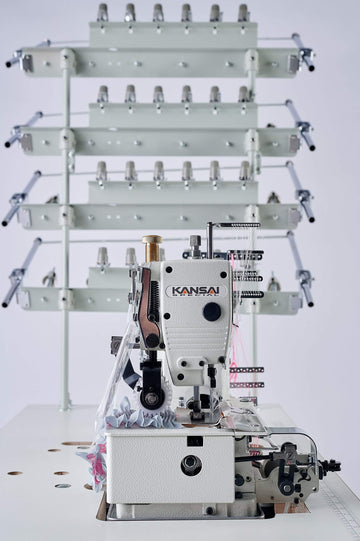Learning how to set up a sewing machine the right way is one of the most empowering skills for anyone who wants to create, repair, or design clothing and accessories. Whether you’re a complete beginner or setting up a brand-new model, understanding each step ensures your stitches are smooth, your fabrics feed evenly, and your machine lasts for years.
If you’ve just brought home your first sewing machine or unboxed an industrial model in Los Angeles or South El Monte, California, this complete guide will walk you through everything — from unboxing to threading — with practical, easy-to-follow instructions. You’ll discover how to set up your sewing machine step by step, how to handle thread set up, and even how to prepare old, manual, and industrial sewing machines for perfect performance.
Why Proper Sewing Machine Set Up Matters
Many new sewists rush through the setup process, only to get frustrated when their fabric bunches or the thread breaks mid-stitch. But taking the time to learn how to set a sewing machine up properly makes all the difference.
A well-set-up sewing machine:
-
Reduces skipped stitches and tangling.
-
Keep your thread tension balanced.
-
Prevents damage to delicate fabrics.
-
Extends your machine’s life and warranty.
This guide is for:
-
Beginners looking for a clear explanation of how to set up a sewing machine for beginners.
-
DIY enthusiasts wanting to learn how to set up sewing machine thread correctly.
-
Sewing students and professionals working with industrial sewing machine set up and installation.
-
Anyone returning to sewing and wondering, “How do I set up a sewing machine again?”
Tools and Materials You’ll Need
Before diving into how to set up your sewing machine, gather these essentials:
-
Sewing machine – domestic, manual, or industrial.
-
Needles and thread – matched to your fabric type.
-
Bobbin and bobbin case.
-
Power source – plug in your electric machine securely.
-
Fabric scraps – for test stitching.
-
Screwdriver, brush, and machine oil – for cleaning and adjustments.
Having everything ready makes your sewing machine set up smoother and faster.
Read Also: Industrial Sewing Machine Brands
How to Set Up a Sewing Machine Step by Step
Now let’s get into the details. Follow these steps carefully to master how to set up a sewing machine step by step — from placement to first stitches.
Step 1: Position Your Machine
Place the machine on a sturdy, flat table. Industrial models should be mounted securely on an industrial sewing machine table with proper lighting and legroom.
Step 2: Install the Needle
Always power off first. Insert the needle with the flat side facing the correct direction (usually the back). Tighten the needle clamp firmly. This part of the needle set up on a sewing machine ensures clean, precise stitches.
Step 3: Wind and Insert the Bobbin
Insert thread through the bobbin winder and fill the bobbin evenly. Once wound, drop it into the bobbin case according to your manual’s diagram. Correct bobbin and thread set up are key to balanced tension.
Step 4: Thread the Upper Path
Follow your machine’s guides, usually numbered. Thread through the tension discs, take-up lever, and finally through the needle eye from front to back. Proper sewing machine thread set up prevents most common issues.
Step 5: Bring Up the Bobbin Thread
Hold the upper thread and turn the handwheel toward you. The needle should pick up the bobbin thread. Pull both threads to the back under the presser foot.
Step 6: Adjust Tension and Presser Foot
Before stitching, test your tension. The thread should appear even on both fabric sides. Lower the presser foot before sewing.
This simple routine is the foundation of how to set up a sewing machine for first-time users. Once done, your machine is ready for a test run.
Thread Set Up and Common Mistakes
One of the most frequent questions beginners ask is how to set up thread on sewing machine models correctly. Threading can be tricky, but once mastered, it becomes second nature.
Quick tips for threading success:
-
Keep the presser foot up while threading.
-
Ensure the thread snaps securely into the tension discs.
-
Always follow the threading diagram specific to your brand.
Avoid these common mistakes:
-
Forgetting the take-up lever.
-
Incorrect bobbin direction.
-
Loose thread ends under the presser foot.
Remember: every smooth stitch starts with a perfect sewing machine thread set up.
Special Setups: Manual, Old, and Industrial Machines
How to Set Up a Manual or Old Sewing Machine
Vintage machines are durable but require patience. When learning how to set up a manual sewing machine or how to set up an old sewing machine, oil the moving parts first. Thread paths may differ slightly, so consult the manual or manufacturer’s guide.
How to Set Up an Industrial Sewing Machine
An industrial sewing machine set up and installation involves more than just threading. Bolt the machine securely to its table, connect the motor belt, and verify oil levels. These machines handle heavy fabrics, so proper calibration ensures safety and stitch quality.
Easy Set Up Sewing Machine Tips for Beginners
-
Use contrasting thread colors for practice.
-
Keep fabric flat and taut while sewing.
-
Watch tutorials specific to your brand (Singer, Brother, Juki).
-
Practice how to set up my sewing machine until it feels automatic.
Troubleshooting Common Set Up Problems
Even when you follow every step, small errors can occur. Here’s how to fix them quickly:
-
Thread bunching: Rethread the machine and reset tension.
-
Needle not moving: Check power connections or bobbin winder position.
-
Uneven stitches: Clean lint from the bobbin area and replace dull needles.
Most setup issues resolve with careful rethreading. If you’re unsure, always revisit the steps on how to set up a sewing machine thread correctly before sewing again.
Final Tips for Perfect Stitching
-
Test before every project: Sew a few lines on scrap fabric to confirm tension and stitch quality.
-
Clean regularly: Dust, lint, and old thread can ruin performance.
-
Keep the manual nearby: Even experts refer to it for threading diagrams.
-
Upgrade your workspace: A sturdy table and good lighting make your sewing machine set up easier and more enjoyable.
For industrial users in California, especially around Los Angeles or South El Monte, ensure your setup complies with safety standards and is properly grounded for commercial environments.
Conclusion
By now, you know exactly how to set up a sewing machine step by step — from installing the needle to threading and tension testing. You’ve learned how to handle sewing machine thread set up, adjust tension, and troubleshoot small issues.
Whether you’re preparing a new sewing machine, reviving a manual model, or installing an industrial setup, the same rule applies: precision during setup leads to perfection in stitching.
Take your time, enjoy the process, and remember — every great garment starts with a properly set-up machine. Once you master how to set up the sewing machine confidently, you’ll be ready to explore more advanced techniques and create professional-quality work right from your own sewing table.
Start today, thread with care, and watch your creativity come alive — stitch by stitch.










